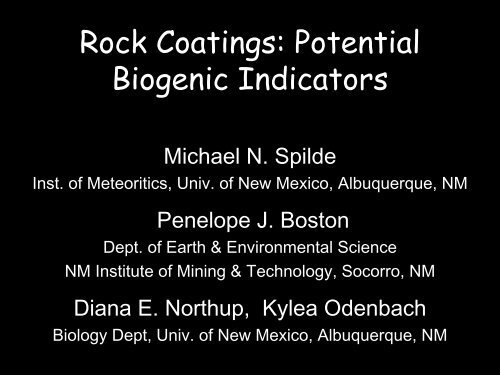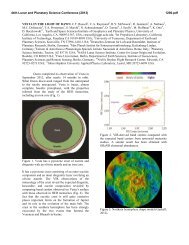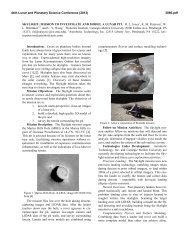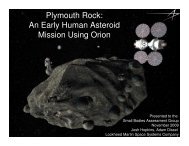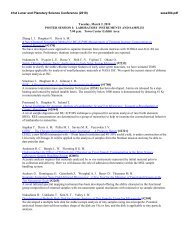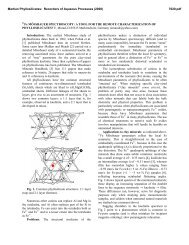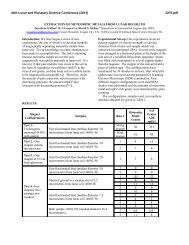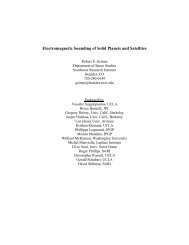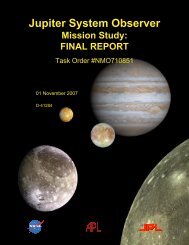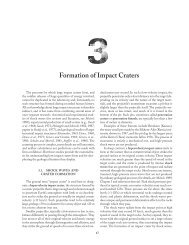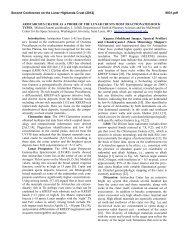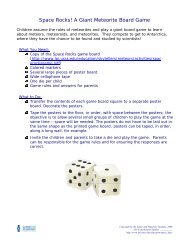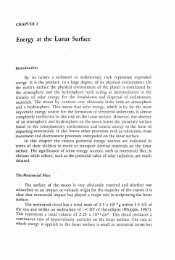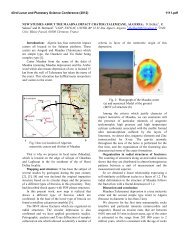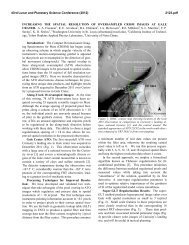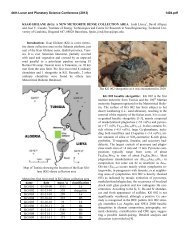Rock Coatings: Potential Biogenic Indicators
Rock Coatings: Potential Biogenic Indicators
Rock Coatings: Potential Biogenic Indicators
You also want an ePaper? Increase the reach of your titles
YUMPU automatically turns print PDFs into web optimized ePapers that Google loves.
<strong>Rock</strong> <strong>Coatings</strong>: <strong>Potential</strong><br />
<strong>Biogenic</strong> <strong>Indicators</strong><br />
Michael N. Spilde<br />
Inst. of Meteoritics, Univ. of New Mexico, Albuquerque, NM<br />
Penelope J. Boston<br />
Dept. of Earth & Environmental Science<br />
NM Institute of Mining & Technology, Socorro, NM<br />
Diana E. Northup, Kylea Odenbach<br />
Biology Dept, Univ. of New Mexico, Albuquerque, NM
<strong>Rock</strong> Crusts & <strong>Coatings</strong><br />
• Interface between the atmosphere & solid<br />
substrate (lithosphere)<br />
• Life on the rocks –an ancient terrestrial niche<br />
(Gorbushina 2007)<br />
• Critical zone: in, under, and on rocks<br />
– endolithic & hypolithic life in deserts and cold regions<br />
– mineral deliquescence<br />
– desert varnish<br />
“Rotten <strong>Rock</strong>s” near Columbia Hills<br />
Bonneville Crater
The Manganese Connection<br />
• Protection from UV radiation<br />
– Among the most radiation-resistant bacterial groups,<br />
Deinococcus, Enterococcus, Lactobacillus, and<br />
cyanobacteria accumulate Mn<br />
– UV resistance exhibits a concentration-dependent response<br />
to Mn(II)-chloride (Daly et al. 2004)<br />
• Protection from oxidation<br />
– Manganese acts catalytically as an antioxidant<br />
– Accumulation of manganese may provide detoxification of<br />
harmful reactive oxygen species (Horsburgh et al. 2002)
Glen Canyon, UT<br />
<strong>Rock</strong> Crusts and <strong>Coatings</strong><br />
Atacama Desert, Chile<br />
Mojave Desert, CA
<strong>Biogenic</strong> <strong>Rock</strong> Varnish Formation
Hanksville, UT<br />
Mojave Desert, CA<br />
Fine Structure in Varnish
Mn concentrated into<br />
specific areas<br />
Fine Structure in Varnish<br />
“Micro-stromatolites”
Socorro, NM<br />
Mn<br />
Fine Structure in Varnish<br />
Mn X-ray map<br />
Botryoidal varnish<br />
BSE image of botryoidal varnish<br />
in thin section
Fine Structure in Varnish<br />
Evidence of debris trapping<br />
in botryoidal structures<br />
Microbial filaments<br />
Micro-colonial fungi
Socorro, NM<br />
BSE image of “bare” rock<br />
Surface Colonization<br />
“Bare <strong>Rock</strong>”<br />
Road cut (apx ( apx 60 yrs old)
Site 607-5: New Varnish Growth<br />
Young Varnish Deposition<br />
Lead smelters in Socorro<br />
operated from 1881-1894<br />
Mn<br />
Pb<br />
Rate of varnish formation =<br />
36 μm/ky<br />
Varnish < 114 yrs old<br />
4 μm
Mineral Deposition in Culture<br />
XRD on manganese minerals produced in<br />
culture: buserite, 10A precursor to birnesite<br />
3.34 A<br />
7.17 A<br />
4.00 A<br />
2.43 A<br />
LL-1 C Spot 1<br />
1.41 A<br />
Synchrotron micro-XRD on rock varnish.<br />
Line spacing matches “hexagonal<br />
birnessite”<br />
Manganese oxides produced in culture by<br />
desert varnish organisms<br />
Manganese oxide crystals on fungal<br />
hyphae
γ-Proteobacteria<br />
Proteobacteria<br />
Cyanobacteria<br />
β-Proteobacteria<br />
Proteobacteria<br />
Actinobacteria<br />
Low G-C G C Gram Positive<br />
Bacteroidetes/Flavobacteria<br />
Bacteroidetes Flavobacteria<br />
Nitrospira<br />
α-Proteobacteria<br />
Proteobacteria<br />
ε-Proteobacteria<br />
Proteobacteria
Known Manganese Oxidizing Fungi<br />
Nonvarnish clones<br />
Varnish clones<br />
Cultures<br />
87<br />
Fungal Phylogenetic Tree<br />
92<br />
60<br />
57<br />
97<br />
93<br />
100<br />
73<br />
56<br />
99<br />
79<br />
89<br />
56<br />
64<br />
63<br />
100<br />
89<br />
98<br />
100<br />
89<br />
100<br />
93<br />
100<br />
100<br />
61<br />
99<br />
65<br />
99 60<br />
99<br />
100<br />
99<br />
56<br />
83 100 100<br />
100<br />
100<br />
K44<br />
AY337712 Phoma herbarum<br />
NVLL3A8<br />
K43<br />
AY923098 Envir. fungi from Whipple Desert Varnish<br />
NVLL3C8<br />
U05194 Alternaria alternata<br />
NVLL3A7<br />
AY923091 Envir. fungi from Whipple Desert Varnish<br />
NVLL3A5<br />
AF250819 Phaeosphaeriopsis glauco-punctata<br />
NVLL3B5<br />
K21<br />
AB195634 Pleosporales sp.<br />
NVLL3C9<br />
L18<br />
NVLL3C2<br />
DV12LL1A12<br />
DV12LL2A2<br />
DQ066714 Cryomyces minteri<br />
EU009479 Aureobasidium pullulans<br />
NVLL3C10<br />
DQ810194 Penicillium sp.<br />
K17<br />
AB008403 Emericella nidulans<br />
X78539 Aspergillus nidulans<br />
L27<br />
K6<br />
K5<br />
K52<br />
M37<br />
M36<br />
AY604526 Endoconidioma populi<br />
AY220610 Scleroconidioma sphagnicola<br />
DQ479933 Dothiora cannabinae<br />
AY552543 Acarospora smaragdula<br />
NVLL3A6<br />
AF548071 Cladosporium cladosporioides<br />
K11<br />
NVLL3B9<br />
AY220613 Capnobotryella renispora<br />
DVLL5C5<br />
L76614 Cenococcum geophilum<br />
DV12LL5A7<br />
AY856939 Helicosporium aureum<br />
AB041250 Phyllosticta pyrolae<br />
AJ888458 Sarcinomyces sp.<br />
AY046271 Neurospora crassa<br />
AY706320 Leohumicola verrucosa<br />
DV12LL2A11<br />
DV12LL1A5<br />
DV12LL1B4<br />
DV12LL1A7<br />
NVLL3A3<br />
NVLL3C5<br />
DV12LL2A7<br />
NVLL3D7<br />
DV12LL1A1<br />
NVLL3D2<br />
DV12LL2A4<br />
NVLL3C7<br />
NVLL3D1<br />
NVLL3C11<br />
DV2bfF11<br />
NV3bfB8<br />
NV3bfB10<br />
DV2bfB11<br />
NV3bfC5<br />
NV3bfC12<br />
NV3bfD7<br />
DV12LL1A2<br />
DV12LL1A11<br />
AY635836 Lecophagus sp.<br />
NVLL3D10<br />
AY923099 Envir. fungi from Whipple Desert Varnish<br />
AY923093 Envir. fungi from Whipple Desert Varnish<br />
EF638564 Uncultured basidiomycete<br />
AB075545 Filobasidium elegans<br />
DV2bfE3<br />
NVLL3A1<br />
DV12LL5B5<br />
AF060452 Pseudoplatyophrya nana<br />
DV12LL5B1<br />
DVLL5B3<br />
AF113430 Mucor racemosus<br />
Ascomycota<br />
Basidiomycota<br />
Zygomycota
The Bottom Line<br />
• There is no “silver bullet” to determine the biogenicity of rock<br />
coatings<br />
– Evidence required from a number of techniques<br />
• Electron microscopy (SEM, FESEM, TEM)<br />
• Mn-enrichment cultures<br />
• Phylogenetic analysis<br />
• Conventional XRD<br />
• Synchrotron XRD<br />
• Difficult to provide in situ & remote analysis<br />
– Sample return will be the only way to adequately analyze coatings<br />
• Fine structures that may be present cannot be preserved if rock<br />
surface is ground up in order to sample<br />
– Coring will be required to preserve structural detail
Acknowledgments<br />
Funding from NSF Biogeosciences Division<br />
Thanks to Armand Dichosa (UNM Biology<br />
Dept) for phylogenetic analysis


